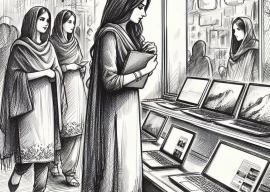
The hotel lobby is a shrine to the author. There are pictures on every inch of the walls: Hemingway on a boat, shaking hands with Castro, writing and laughing — Hemingway doing everything. One of them, a particularly striking close-up of the author kissing one of his four wives, Martha Gellhorn, catches my eye. It is the least Hemingway-esque photograph among the collection, and stirs a quote from the author in my mind, “The best writing is certainly when you are in love.”

A view of Hemingway’s living room in his farmhouse, located in the small Cuban village of San Francisco de Paula. PHOTO CREDIT: KHAVER SIDDIQI

The author’s single bed in Room 511 of Hotel Ambos Mundos. PHOTO CREDIT: KHAVER SIDDIQI
Hemingway’s love for Cuba began in the early 1930s. It was in 1932 that he discovered the hotel and took up residence in Room 511. This would be his writing space for the next seven years and the place where he started work on For Whom the Bell Tolls.
The hotel building has a pinkish hue, reminiscent of 1940s and 1950s art-deco style. It is located in the heart of Old Havana or Havana Vieja as it is known in Spanish. Not far from the hotel, there are hundreds, if not thousands of books for sale in tiny stalls on the Plaza de Armas town square.
I take the slow hotel elevator up five floors to Room 511. As I get out on the fifth floor, I’m greeted by yet another picture of Hemingway: the writer meeting Castro. A guide informs me that only four people are allowed in Room 511 at a time and so I wait while a German tour group goes before me. Twenty minutes later, the group emerges from the room. I don’t speak German but I can tell the tourists are unimpressed. Then the guide motions me into this hotel room which has been turned into a mini-museum.
The room is triangular in shape and the corner is covered by windows that look out onto the rooftops of Old Havana through to Castillo Morro Fort on the other side of the harbour. The breeze brings with it sounds of the streets below and the not-so-distant smell of the ocean.
In front of the window, in the centre of the room, is a small table and chair and upon the table, ensconced in a glass box, lies Hemingway’s typewriter. I thought the view from the windows had taken my breath away but the sight of the typewriter makes my heart stop. It is magnificent. A writer’s weapon has never before been so gloriously displayed.

Photographs of the author and a framed copy of his signature are displayed in the lobby of Hotel Ambos Mundos. PHOTO CREDIT: KHAVER SIDDIQI

Ernest Hemingway and Cuban leader Fidel Castro first met in 1960 at a fishing contest held in the author’s honour. PHOTO: AP
Across the typewriter is a small, single bed and next to it are Hemingway’s fishing rods. While Hemingway stayed at the hotel, he used his boat, named the Pilar, to fish in Havana’s harbour. On the wall, mounted in a glass case, is the original telegram Hemingway received (not at the hotel) in 1954, announcing that he had won the Nobel Prize for Literature. It bears his handwritten notes.
Just an hour away from Hotel Ambos Mundos, in the small village of San Francisco de Paula, there is a farm. Finca Vigía (Lookout Farm) is no ordinary farm. One of the things that you immediately notice here, besides the animal heads on the walls and a half burnt cigar in an ash tray in the living room, is that there are books everywhere.
Almost every room — even the bathroom — has a bookshelf. I spot many classics here — T S Eliot’s Collected Poems, Charles A Beard’s The Republic and Alden Brooks’s Shakespeare and the Dyer’s Hand to name a few. But there are no books in the dining room. Either Hemingway subscribed to the thought that reading whilst eating was rude or his passion for writing was only surpassed by his passion for food. I’d like to think it was the latter.

A telegram informing Hemingway that he had won the Nobel Prize for Literature for The Old Man and the Sea in 1954. PHOTO CREDIT: KHAVER SIDDIQI
Like Hotel Ambos Mundos, there are tour guides here too but this place is more special than room 511. This is the place almost all Hemingway enthusiasts visit; they crowd around his boat and walk around his empty swimming pool — the writer famously swam half a mile every day — and look at the graves of Hemingway’s beloved cats right across the pool. Four tombstones bear their names: Black, Negrita, Linda and Neron.
The centre piece of this location is the tower that stands in the middle of the farm, watching over all of it. Hemingway had the tower built once he moved here and it is the perfect retreat within a retreat. The tower is only three or four stories high but once you’re up there and see La Habana in the distance, you realise you are far away from everything and everyone. Hemingway often said that it was the characters in his stories that would drive him up here and force him to write. He wrote in seclusion and famously said, “The telephone and visitors are the work destroyers.”

Ernest Hemingway’s typewriter, as displayed in Hotel Ambos Mundos’ Room 511. PHOTO CREDIT: KHAVER SIDDIQI
Although I was standing in the shadow of the tower, I could feel Hemingway’s weighty shadow despite him being here a lifetime ago. And with his presence came a realisation: what was left in his room and the farm was a reenactment of how the writer’s life may have appeared. Nobody knows how Hemingway filled these spaces.

All of this staging was a flame to draw an eclipse of moths — the tourists. But not all tourists are writers or aspiring to be one, and for them, Room 511 is a simple room with a typewriter, some fishing rods and an average Cuban view. But for an aspiring writer, everything about that room is intoxicating. The tourists followed Hemingway to find an empty room and a barren farm, while I followed Hemingway and found a writer’s spirit. It was as if he was showing me: this is how a writer lives and writes.
Khaver Siddiqi is a social media consultant living in Chennai, India. He tweets @thekarachikid
Published in The Express Tribune, Sunday Magazine, March 1st, 2015.























COMMENTS
Comments are moderated and generally will be posted if they are on-topic and not abusive.
For more information, please see our Comments FAQ